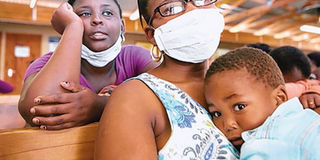Diagnosing childhood TB still a challenge

What you need to know:
- We all want our children to be protected and so we do anything in our capacity to ensure they remain in good health.
- Sometimes, adults become the source of disease to children. Children who are diagnosed with tuberculosis have been infected in many cases by adults.
Diseases among children have always caught our attention in a very special and particular manner.
We all want our children to be protected and so we do anything in our capacity to ensure they remain in good health.
Sometimes, adults become the source of disease to children. Children who are diagnosed with tuberculosis have been infected in many cases by adults.
How does this happen?
Contact of children to adults who have tuberculosis is the main way on how tuberculosis gets to children.
Tuberculosis is transmitted through air whereby a person with the disease, cough or sneeze and release tuberculosis bacteria in the air and children in contact get to breath in the air with bacteria hence gets the infection.
Although tuberculosis infection does not necessarily mean one will develop disease, the risk of developing disease is higher in children compared to adults.
The challenge of diagnosing TB in children
Diagnosis of tuberculosis among children is the most challenging aspect in childhood tuberculosis.
• First, in order to diagnose tuberculosis one has to cough out sputum which will be examined for the presence of tuberculosis bacteria.
Collecting sputum in child of say one year of age will be difficult since getting good sputum requires one to follow appropriate instructions.
Furthermore, children tend to swallow sputum instead of coughing it out.
There are techniques which are used to collect swallowed sputum from the stomach, however such techniques need qualified and experienced healthcare workers.
• Second, even in situations where we can collect sputum in children, the nature of the disease itself among children presents with very low bacterial load, which may not meet the minimum number to be visible under the microscope.
• Third, tuberculosis in children quickly spread to other parts of the body and often presents as disease outside the lung.
This means a child can still have the disease but without bacteria in sputum.
The disease also presents with severe form in children in tuberculosis meningitis where bacteria affect the spine and the brain.
Treatment of tuberculosis is essentially similar to both adults and children.
Solution
Generally, childhood tuberculosis constitutes 10 per cent of all tuberculosis notification in Tanzania, of which more than half of those are diagnosed based on clinical judgement.
There many different diagnostic tools which are in different stages of development evaluation or validation for use to diagnose childhood tuberculosis.
Some have been designed to use samples which can be easily collected, such as urine while others are molecular based which are expected to be more valid.
The future of childhood tuberculosis control will depend on availability of simple valid and user friendly diagnostic tools, which can make use specimen such as urine and can be used in the lowest settings of healthcare, such as dispensary.
Protecting our children by not exposing them to those with active tuberculosis, early diagnosis and preventive therapy for those exposed will remain core in the fight against childhood tuberculosis.
Furthermore, is increasing active case findings and screening of children in household with a tuberculosis patient as well as improvement in nutrition and proper house ventilation.
Proper surveillance systems for early detection and treatment initiation will remain instrumental in tuberculosis control programs.




